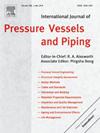Assessment of AM70 high-strength steel processed via wire arc additive manufacturing for pressure vessel applications: Role of spray and pulsed arc
IF 3.5
2区 工程技术
Q2 ENGINEERING, MECHANICAL
International Journal of Pressure Vessels and Piping
Pub Date : 2025-09-30
DOI:10.1016/j.ijpvp.2025.105671
引用次数: 0
Abstract
Achieving optimal mechanical performance in wire arc additive manufacturing (WAAM) of high-strength low-alloy (HSLA) steels is critical for the structural integrity of load-bearing and pressure-retaining components. This study compares the effects of high-capacity Spray Arc and voltage-controlled Pulsed Arc gas metal arc welding (GMAW) modes on the microstructure, residual stress distribution, and mechanical behavior of AM70 HSLA steel, an alloy formulated for enhanced arc stability and deoxidation. Comprehensive characterization using optical/electron microscopy, X-ray diffraction, mechanical testing, and fractography reveals distinct process–structure–property relationships. Pulsed Arc mode produces a refined acicular ferrite matrix with more uniform crystallite size and elemental homogeneity, leading to superior hardness (236–246 HV5 vs. 223–235 HV5), tensile strength (743–793 MPa vs. 687–710 MPa), and Charpy impact toughness (78.5–103 J vs. 59.3–78.2 J) compared to Spray Arc. Additionally, compressive residual stresses are more uniformly distributed under Pulsed Arc (−134 to −288 MPa), whereas Spray Arc introduces steeper gradients (−66 to −311 MPa), which could affect long-term structural performance. Although Spray Arc yields higher ductility (34.7–36.4 % vs. 29.1–32.9 %), Pulsed Arc offers a better balance of strength and toughness. Fractographic analysis confirms ductile failure modes in both cases, with finer dimple morphology observed in Pulsed Arc samples. These findings demonstrate the potential of Pulsed Arc WAAM with AM70 steel for manufacturing pressure-resilient and structurally reliable HSLA steel components.

压力容器用电弧丝增材制造加工的AM70高强度钢的评估:喷射电弧和脉冲电弧的作用
在高强度低合金(HSLA)钢的电弧增材制造(WAAM)中实现最佳机械性能对承载和保压部件的结构完整性至关重要。本研究比较了大容量喷射电弧和电压控制脉冲电弧气体金属电弧焊(GMAW)模式对AM70 HSLA钢的显微组织、残余应力分布和力学行为的影响,AM70 HSLA钢是一种旨在增强电弧稳定性和脱氧的合金。利用光学/电子显微镜、x射线衍射、力学测试和断口学进行综合表征,揭示了不同的工艺-结构-性能关系。脉冲电弧模式产生了精细的针状铁素体基体,具有更均匀的晶粒尺寸和元素均匀性,与喷射电弧相比,具有更高的硬度(236-246 HV5 vs 223-235 HV5),抗拉强度(743-793 MPa vs 687-710 MPa)和Charpy冲击韧性(78.5-103 J vs 59.3-78.2 J)。此外,脉冲电弧(- 134至- 288 MPa)下的残余压应力分布更均匀,而喷雾电弧的残余压应力梯度更陡(- 66至- 311 MPa),可能会影响结构的长期性能。尽管喷射电弧具有更高的延展性(34.7 - 36.4% vs 29.1 - 32.9%),但脉冲电弧具有更好的强度和韧性平衡。断口分析证实了两种情况下的延性破坏模式,在脉冲电弧样品中观察到更细的韧窝形态。这些发现证明了脉冲电弧WAAM与AM70钢在制造抗压力和结构可靠的HSLA钢部件方面的潜力。
本文章由计算机程序翻译,如有差异,请以英文原文为准。
求助全文
约1分钟内获得全文
求助全文
来源期刊
CiteScore
5.30
自引率
13.30%
发文量
208
审稿时长
17 months
期刊介绍:
Pressure vessel engineering technology is of importance in many branches of industry. This journal publishes the latest research results and related information on all its associated aspects, with particular emphasis on the structural integrity assessment, maintenance and life extension of pressurised process engineering plants.
The anticipated coverage of the International Journal of Pressure Vessels and Piping ranges from simple mass-produced pressure vessels to large custom-built vessels and tanks. Pressure vessels technology is a developing field, and contributions on the following topics will therefore be welcome:
• Pressure vessel engineering
• Structural integrity assessment
• Design methods
• Codes and standards
• Fabrication and welding
• Materials properties requirements
• Inspection and quality management
• Maintenance and life extension
• Ageing and environmental effects
• Life management
Of particular importance are papers covering aspects of significant practical application which could lead to major improvements in economy, reliability and useful life. While most accepted papers represent the results of original applied research, critical reviews of topical interest by world-leading experts will also appear from time to time.
International Journal of Pressure Vessels and Piping is indispensable reading for engineering professionals involved in the energy, petrochemicals, process plant, transport, aerospace and related industries; for manufacturers of pressure vessels and ancillary equipment; and for academics pursuing research in these areas.

 求助内容:
求助内容: 应助结果提醒方式:
应助结果提醒方式:


